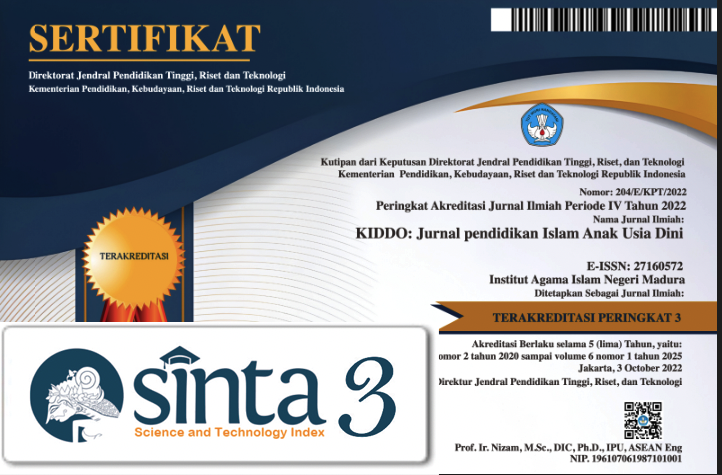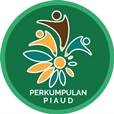Membentuk Ketahanmalangan Anak di Lingkungan Sekolah Melalui Permainan Tradisional
 Abstract views: 152
,
Abstract views: 152
,
 PDF downloads: 117
PDF downloads: 117
Abstract
Efforts to optimize children's development are based on strengthening children's resilience to adversity. One way to build children's resilience is by facilitating children to play outdoors, namely through traditional games. In this research, traditional games were limited to Gobak Sodor and Skipping Rope by examining 25 children aged 5-7 years. The research was carried out in 2 cycles to get results on indicators (1) Solving problems independently, the results of cycle 1 were 63%, while the results of cycle II were 97%; (2) Not giving up easily, the results in cycle I were 67%, while in cycle II it was 94%; (3) Hardiness results in cycle I were 67%, while in cycle II it was 93%; (4) Liked the challenge, getting results in cycle I was 65%, while in cycle II it was 98%; (5) Dare to take risks and the results in cycle I were 68%, while in cycle II the results were 95%.Efforts to optimize children's development are based on strengthening children's resilience to adversity. One way to build children's resilience is by facilitating children to play outdoors, namely through traditional games. In this research, traditional games were limited to Gobak Sodor and Skipping Rope by examining 25 children aged 5-7 years. The research was carried out in 2 cycles to get results on indicators (1) Solving problems independently, the results of cycle 1 were 63%, while the results of cycle II were 97%; (2) Not giving up easily, the results in cycle I were 67%, while in cycle II it was 94%; (3) Hardiness results in cycle I were 67%, while in cycle II it was 93%; (4) Liked the challenge, getting results in cycle I was 65%, while in cycle II it was 98%; (5) Dare to take risks and the results in cycle I were 68%, while in cycle II the results were 95%.
Downloads
References
Arikunto, S. (2012). Penelitian Tindakan Kelas. Bumi Aksara.
Casey, T. (2007). Environments for Outdoor Play: A Practical Guide to Making Space for Children. SAGE Publications Ltd. https://doi.org/https://doi.org/10.4135/9781446214206
Chairilsyah, D., Kurnia, R., & Putra, Z. H. (2022). Adversity quotient in early childhood post-Covid 19: Analysis of the role of parents. Journal of Positive School Psychology, 6(8), 5310–5321. https://www.journalppw.com/index.php/jpsp/article/view/10779
Garbarino, J., & Sigman, G. (n.d.). A Child’s Right to a Healthy Environment (The Loyola University Symposium on the Human Rights of Children). www.springer.com/series/7885
Isratati, Y., & Mahyuddin, N. (2022a). Kemampuan Adversity Quotient pada Anak Usia Dini Pasca Covid-19. Jurnal Obsesi : Jurnal Pendidikan Anak Usia Dini, 6(6). https://doi.org/10.31004/obsesi.v6i6.3484
Isratati, Y., & Mahyuddin, N. (2022b). Kemampuan Adversity Quotient pada Anak Usia Dini Pasca Covid-19. Jurnal Obsesi : Jurnal Pendidikan Anak Usia Dini, 6(6), 6899–6908. https://doi.org/10.31004/obsesi.v6i6.3484
Manurung, A. K. R., Wulan, S., & Purwanto, A. (2021). Permainan Outdoor dalam Membentuk Kemampuan Ketahanmalangan pada Anak Usia Dini. Jurnal Obsesi : Jurnal Pendidikan Anak Usia Dini, 5(2), 1807–1814. https://doi.org/10.31004/obsesi.v5i2.1030
Mu’mala, K. A., & Nadlifah, N. (2019). Optimalisasi Permainan Lompat Tali dalam Mengembangkan Motorik Kasar Anak. Golden Age, 4. https://doi.org/https://doi.org/10.14421/jga.2019.41-06
Nissa, H. Z., Mustaji, M., & Hendratno, H. (2020). Gross Motor and Social Development of Children Development Media of Traditional Jumping Rope Modification Game. International Journal for Educational and Vocational Studies, 2(9), 776–783. https://doi.org/10.29103/ijevs.v2i9.2706
Nuria, R. (2022). Dampak Gaya Pengasuhan Orang Tua terhadap Sikap Nomophobia pada Anak Pendahuluan. JIPS: Jurnal Ilmu Pendidikan Dan Sains Islam Interdisipliner, 1(2), 63–69.
Stoltz, P. G. (2005). Adversity quotient : mengubah hambatan menjadi peluang. Grasindo.
Susena, Y. B., Santoso, D. A., & Setyaningsih, P. (2021). Ethnosport Permainan Tradisional Gobak Sodor. Jurnal Pendidikan Kesehatan Rekreasi, 7(2). https://doi.org/https://doi.org/10.5281/zenodo.5035410
Umi Susiana Dewi, & Ratri Nuria. (2019). Pengaruh Pola Asuh Orang Tua Terhadap Prestasi Belajar Siswa-Siswi Kelas VIII SMPN 1 Gembong Pati Jawa Tengah Tahun Ajaran 2013-2014. AL-FAHIM: Jurnal Manajemen Pendidikan Islam, 1(1), 87–112. https://doi.org/10.54396/alfahim.v1i1.52
Wahyuni, S. (2022). Kurikulum Merdeka untuk Meningkatkan Kualitas Pembelajaran. Jurnal Pendidikan Dan Konseling, 4(6), 13404–13408.
Winaya, I. M. dkk. (2021). Penguatan Ketahan Malangan (Adversity Question) Pada Anak Usia Dini Melalui Pendidikan Karakter Di Lingkungan Keluarga. Jurnal Pendidikan Anak Usia Dini, 2, 139–148.
Copyright (c) 2024 RATRI NURIA

This work is licensed under a Creative Commons Attribution 4.0 International License.
-
The journal operates an Open Access policy under a Creative Commons 4.0 International license. The terms of the license are:
Share— copy and redistribute the material in any medium or format
Adapt— remix, transform, and build upon the material for any purpose, even commercially.
1. Authors retain copyright and grant the journal right of first publication with the work simultaneously licensed under a Creative Commons License.that allows others to share the work with an acknowledgement of the work’s authorship and initial publication in this journal
2. Authors are permitted and encouraged to post their work online (e.g., in institutional repositories or on their website) prior to and during the submission process, as it can lead to productive exchanges, as well as earlier and greater citation of published work (See The Effect of Open Access).
Jurnal Kiddo is licensed under a Creative Commons
n Access).














